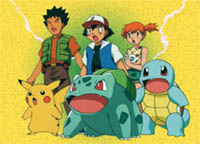June 13, 2005
Animation on television, child-safe and otherwise.
ZOINKS!The Arcade Generation
 |
In 1983, I was eleven years old and fully addicted to arcade games. My Atari 2600 was great, but the cutting-edge games were at the arcades. Q*Bert, Donkey Kong Jr., and Frogger were all available for the home systems, but the arcade versions were so superior, and I tossed quarter after quarter into those machines. So when CBS announced Saturday Supercade, I was ecstatic. Toons based on all those titles, as well as Space Ace and other assorted games? What more could I ask for?
Well, how about good writing, or a plot?
| The problem with a game like, say, Q*Bert, is that there's really no world to build on. You've got a short guy who hops on cubes and changes their colors, until he changes every last one, in which case the level starts over again. |
If the toons in the Saturday Supercade anthology were bad, the standalone toons based on '80s games didn't fare much better. ABC's Pac-Man (which, for those of you with better cable companies than my lame-ass Comcast, can still be watched on Boomerang) was a Hanna-Barbara massacre of the characters, with animation that actually flirted with being worse than the game itself and such concepts as Chomp-Chomp the Pac-Dog and Sour Puss the Pac-Cat. The less said about the evil Mezmaron, the mastermind behind the attacks of the ghosts, the better. CBS's Pole Position was more watchable, combining the better elements of Speed Racer and Johnny Quest, and was probably the only early '80s arcade toon worth the time.
 |
The mid-'90s were probably the closest thing to halcyon days. In the post-Animaniacs era, even commercial tie-ins had to put in a little effort, and Mega-Man and Earthworm Jim both provided solid viewing. Mega-Man, based on the classic Nintendo games, took itself a little too seriously, but was a solid sci-fi toon, and as good a way as any to kill half an hour. Earthworm Jim, on the other hand, bordered on brilliant. Taking the zaniness of the Sega game to the extreme, Jim fought Evil the Cat, Bob the Killer Goldfish, and other surreal villains in a show whose videogame roots probably caused it to be overshadowed by peers such as The Tick and Freakazoid*. Of course, neither of these makes up for the mid-'90s blemishes of Double Dragon and Street Fighter, two truly horrendous cartoons. But at least we'd finally seen evidence that videogame-inspired toons could actually be worth watching.
Nowadays, with the Pokemon juggernaut somehow not dying out like it should, it's hard to be optimistic about the game/toon merger. But given the vast amounts of storage space and processing power available to game developers today, they can tell a story in the game itself. Why bother with a separate license for something like Jak and Daxter when the PS2 can tell the entire tale? Likewise, every single toon on Disney, Nickelodeon, and Cartoon Network has at least one licensed web game, so kids today don't have any sense of there being anything special about a licensed property anymore. We'll still see Pokemon, Digimon, and other toons, but they're positioned now as a part of a media chain, designed to work in synergy with the videogames, card games, and books, not as individual cartoons that can be enjoyed on their own. Frustrating as that can be, it's a hell of a lot better than the idea of seeing Saturday Supercade again.
*Not that The Tick and Freakazoid weren't better shows — they were — but with such a glut of top-notch super-heroic zaniness, the market was over-saturated.
Email the author.
All written content © 2005 by the authors. For more information, contact homer@smrt-tv.com
